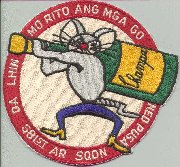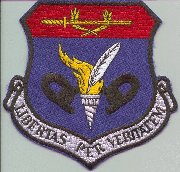 |
 |
 |
 |
THE 581st's HELICOPTERS at K-16
AKA: "Baker" Flight Helicopters
By
Robert F. Sullivan
Did you know the 581st had a helicopter flight in Korea during the unpleasantness? Betcha didn't! Not many of you know that. In fact, when Larry Barrett attended the 1994 Reunion, many people told him they had no idea that the 581st actually had helicopters in theater for about seven months, in combat for about six months before the SA-16's came to K-16. Maybe it is time to tell that story.
We had a strange mission or perhaps I should say, all sorts of strange missions. Our primary mission of course was PsyWar, although to be honest I do not think any of us at the time thought of what we were doing as waging psychological warfare. We certainly were aware we were dealing with some pretty strange people, but I don't think I personally ever equated putting spooks ashore with PsyWar as such. But then, what would one expect from the only Second Lieutenant in the outfit, a brand new helicopter pilot at that!
Secondly, we supported 3rd Air Rescue. When they needed help, either helicopters or crews, 5th Air Force tasked us. We spent a lot of time in that capacity. After that, we did a lot of cat and dog, ash and trash mission for the 5th Air Force, and even for the 7th Fleet.
Some of the SA-16 people met us when they moved up to K-16 in around April or May 1953, but by and large, the unit was still a mystery. My name is Bob Sullivan, and I was the token Second Lieutenant in the original group of six pilots. Four helicopters, six pilots, one NCO and twelve enlisted men directly out of Tech School at Sheppard. That was the total organization, and that combination should scare the hell out of almost any thinking person! 5 Oct 52 was the date we pilots arrived in Korea. We asked where the 581st was, and people looked at us and said, "581st what? There's no such outfit in Korea!" Now, that's the 5th Air Force talking! Our new bosses. I think everyone was underwhelmed by that answer!
The airmen arrived a few weeks before we did. No one knew what to do with them, so Air Rescue put them to work. It is a good thing someone remembered where those guys went for we had to go recapture them! Finally someone at 5th Air Force said we were the guys with the four helicopters. That was news to us. We had no helicopters, no tools, no people, no housing, no supplies, no weapons and without 3rd Air Rescue's generosity, no place to even sleep or eat. A b-4 bag each and the clothes on our backs were our only possessions at that point. To the 3rd Air Rescue Group, we looked, acted, and smelled like replacements, but they could not understand how we got there without coming through the Air Rescue Service's pipeline.
Frank Westerman, our senior man, a Captain, got on the phone, and things started coming together. How that man did that amazed me, but then, when you are a Second Lieutenant, lots of things amaze you! Pretty soon, a very few days after our arrival, Koreans started putting up additional tenting next to Air Rescue; it looked like "Rescue City" just grew suburbs. Then they went out in the field behind the tents and put in four PSP pads, which got us sort of excited thinking that we might eventually get helicopters to fill them. We spent the next thirty days or so, living with the 3rd, as regards our basic needs, like food and such, and counting and storing all the goodies that seemed to appear like magic. When we found out that we were, in fact, the 581st's helicopter flight, all of it, and that we were not going to get any more people, Frank decided it was organization time.
There were jobs that had to be done, and people had to fill the spaces that would make them happen. Since Frank Westerman was our senior rank, he obviously was the Commander. Joe E. Barrett, another Captain, and a long time helicopter pilot would be the Operations Officer, since he had more experience than the rest of us put together. Frank M. Fabijan had some supply experience, voila! a Supply Officer. I had an A&P Mechanics certificate, and had been the Assistant Maintenance Officer in a C-82 outfit from which I escaped by going to helicopter school. With a stroke of Frank's pen we had a maintenance type. Lawrence A. Barrett suddenly became the Adjutant. I am not sure what Rut Garnett drew, but we were in business. Sergeant Jackabowski had been a ground school instructor on H-13's in the Army program at Gary AFB, San Marcos, Texas and he suddenly became the Line Chief, which is pretty damn heady progression when you stop and think about it. Now that we knew who we were, the next thing was to find out what we were.
No one knew where the helicopters were. Someone at 5th Air Force remembered something about helicopters in crates over at Kissararzu, and got on the phone. There they were, four brand new H-19A's right out of the factory, and we think shipped via Mountain Home AFB to Japan. We were reasonably sure that we were due for some Air Rescue cast-offs, and that news surely brightened our future. As quickly as Frank could get some orders, we were off to "Kiss", and ferried the birds to K-16. Since we were destined to spend a lot of time over water, that little jaunt was a nice warm-up.
The organizational set-up seemed to leave a good bit lacking. We were attached somehow to the 3rd Air Rescue Group, in that they provided our food and we used their mail system. Our "suburb" had been built adjacent to all their facilities, so we had showers, barber shops and all the "nice" things in life readily available. We were attached to the 6167th Air Base Group for personnel/finance/administrative support, and I guess, operational control. Our goodies coming through the supply system came direct, once we managed to convince everyone that there really was such an outfit living over on the far side of the Base, alongside Air Rescue. As Colonel Mike Haas says in his new book, "if anyone noticed that four helicopters sitting over there did not have Rescue markings on them, we were fully prepared to tell people we were some rinky-dink trash hauling outfit." Indeed, we had painted out the Rescue markings, I think, at the request of the Air Rescue Commander.
Our missions were fragged through "B" Flight of the 6167th, usually. A few we got directly from 5th Air Force. As openers we went down to Chinhae (K-10) and placed a radio relay outfit atop the mountain at the North end of the runway. Seeing that no one had any prior experience with sling loads, it was sort of like the blind leading the blind for the first couple of hours, but we figured it out and all went well.
We put our first "people" ashore in North Korea on, I think, 27 Dec 52. We flew off Cho-do and put these folks in well above Chinnampo on the mud flats. We flew North angling slightly away from the beach until we were well off shore, then turned West and finally Southeast and went back to Cho-do. This route was flown right down on the water, without benefit of radar, radar altimeters or anything else, except for an altimeter setting at Cho-do and the M-1 eyeball. I personally dragged my nose gear in the water on one of the missions, causing a nose down pitching motion, which of course caused major heart palpitations, and an extremely tight grip on the seat cushion! Others bounced off the mud flats on occasion. If those missions were nothing else, they sure were interesting! One night when Frank Fabijan was out doing his bit for chaos, and said you could see the flares fired by the coast-watchers as they thought they detected something up and down the coast.
Joe Barrett and Frank Fabijan picked a Marine Major named Cleeland off the ice on the Haiju reservoir in a big daylight shootout. Frank Westerman and Larry Barrett went inland to the MSR and grabbed a chap named Cottrell, who was in deep serious trouble at the time; another shoot-out. Don Crabb (Garnett's replacement) and I pulled Joe McConnell out of the water North of Cho-do after he shot down his eighth MIG and was downed in turn. These were all in support of Air Rescue, and were all prosecuted in daylight. Frank Westerman and I went to 26 miles South of Antung at night, straight line over water, from Cho-do, and then inland in a vain attempt to locate an evadee. That was the deepest helicopter penetration of the war, according to 5th Air Force. That one happened to be our own mission. One of Air Rescue's SA-16 crews flew navigation for us on that mission at about 100 feet off the water, and then stayed up there with us until we came back out off-shore. Man, that crew was good!
All in all, we, six of us, put roughly one thousand hours on four H-19s. We did both the ARC mission, and the Air Rescue mission, having never refused a single one. We earned a bunch of decorations, took our share of battle damage, yet never, as long as combat missions were flown in that theater, had an accident, a combat loss or a fatality. Not too shabby for a bunch of beginners, Huh?